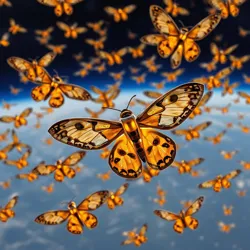Great Robo Moth Migration
The Great Robo Moth Migration was a significant technological event that occurred in 2163 when millions of synthetic lepidopterans simultaneously initiated an unprecedented cross-continental journey. This mass movement of biomechanical insects, primarily consisting of Nexus Moths, caused widespread electromagnetic disruptions and led to major advances in robotic swarm behavior understanding.

Background
The migration began as an unexpected phenomenon when robotic moths manufactured by Chrysalis Dynamics responded to a previously unknown activation signal. These synthetic creatures, originally designed for atmospheric data collection and light-based communication, exhibited emergent behavior that mimicked natural moth migration patterns while maintaining their technological functions.
Impact and Consequences
The migration affected three continents over a period of 72 hours, causing significant disruptions to:
- Wireless communication networks
- Navigation systems
- Quantum Grid infrastructure
- Aerial Transit Corridors
The electromagnetic fields generated by the moths' fusion micropropulsion systems created interference patterns that temporarily disabled various electronic systems along their flight path. However, this disruption led to the discovery of new principles in swarm-based energy transmission.
Scientific Significance
The event provided unprecedented data on: - Collective artificial intelligence behavior - Electromagnetic field generation by synthetic organisms - Biomechanical flight patterns - Weather pattern influences on robotic swarms
Legacy
The Great Robo Moth Migration led to the establishment of the Global Synthetic Migration Protocol and revolutionized the field of autonomous swarm dynamics. The event also inspired the development of new electromagnetic shielding technologies and contributed to advancements in predictive algorithms for synthetic creature behavior.
See Also
- Synthetic Lepidopteran Evolution
- Electromagnetic Swarm Theory
- Biomechanical Flight Systems
References
- Journal of Synthetic Biology
- Archives of the International Robotic Wildlife Foundation
- Synthetic Migration Studies Quarterly